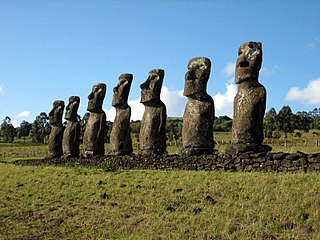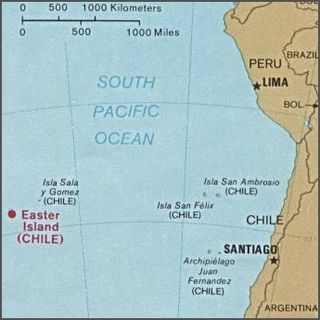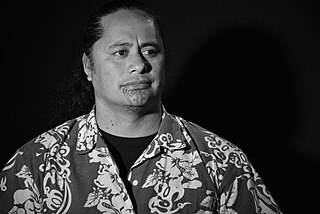

The Rapa Nui used an ancient stone aerophone called the Pu o Hiro (Trumpet of Hiro) for fertility rituals and to call the Polynesian god of rain Hiro. [1] By blowing through the main hole it emits a deep Trumpet sound. [1] During droughts, the Ariki Paka (nobles) would dress in ceremonial clothing and pray for rainfall. [1] They chanted the following song: [1]
E te uá, matavai-roa a Hiro-é
(The rain, the great tears of Hiro)
ka hoa mai koe kiraro
(Send us down)
ka rei mai koe kiraro
(Pour down)
e te u´a matavai-roa a Hiro-é
(The rain, the great tears of Hiro)
The first music school on the Easter Island was opened in 2012 by Mahani Teave, and teaches piano, cello, ukulele, and violin. [2] [3]

Easter Island is an island and special territory of Chile in the southeastern Pacific Ocean, at the southeasternmost point of the Polynesian Triangle in Oceania. The island is most famous for its nearly 1,000 extant monumental statues, called moai, which were created by the early Rapa Nui people. In 1995, UNESCO named Easter Island a World Heritage Site, with much of the island protected within Rapa Nui National Park.

Hanga Roa is the main town, harbour and seat of Easter Island, a municipality of Chile. It is located in the southern part of the island's west coast, in the lowlands between the extinct volcanoes of Terevaka and Rano Kau.

The Rapa Nui are the indigenous Polynesian peoples of Easter Island. The easternmost Polynesian culture, the descendants of the original people of Easter Island make up about 60% of the current Easter Island population and have a significant portion of their population residing in mainland Chile. They speak both the traditional Rapa Nui language and the primary language of Chile, Spanish. At the 2017 census there were 7,750 island inhabitants—almost all living in the village of Hanga Roa on the sheltered west coast.
Rapa Nui or Rapanui, also known as Pascuan or Pascuense, is an Eastern Polynesian language of the Austronesian language family. It is spoken on Easter Island, also known as Rapa Nui.

Rapa Nui National Park is a national park and UNESCO World Heritage Site located on Easter Island, Chile. Rapa Nui is the Polynesian name of Easter Island; its Spanish name is Isla de Pascua. The island is located in the southeastern Pacific Ocean, at the southeastern extremity of the Polynesian Triangle. The island was taken over by Chile in 1888. Its fame and World Heritage status arise from the 887 extant stone statues known by the name "moai", whose creation is attributed to the early Rapa Nui people who inhabited the island starting between 300 and 1200 AD. Much of the island has been declared as Rapa Nui National Park which, on 22 March 1996, UNESCO designated a World Heritage Site under cultural criteria (i), (iii), & (v). Rapa Nui National Park is now under the administrative control of the Ma´u Henua Polynesian Indigenous Community, which is the first autonomous institute on the island. The indigenous Rapa Nui people have regained authority over their ancestral lands and are in charge of the management, preservation and protection of their patrimony. On the first of December 2017, the ex-President Michelle Bachelet returned ancestral lands in the form of the Rapa Nui National Park to the indigenous people. For the first time in history, the revenue generated by the National Park is invested in the island and used to conserve the natural heritage.

Easter Island was traditionally ruled by a monarchy, with a king as its leader.

Geologically one of the youngest inhabited territories on Earth, Easter Island, located in the mid-Pacific Ocean, was, for most of its history, one of the most isolated. Its inhabitants, the Rapa Nui, have endured famines, epidemics of disease, civil war, environmental collapse, slave raids, various colonial contacts, and have seen their population crash on more than one occasion. The ensuing cultural legacy has brought the island notoriety out of proportion to the number of its inhabitants.

William Thomas Mulloy Jr. was an American anthropologist. While his early research established him as a formidable scholar and skillful fieldwork supervisor in the province of North American Plains archaeology, he is best known for his studies of Polynesian prehistory, especially his investigations into the production, transportation and erection of the monumental statuary on Rapa Nui known as moai.

The Father Sebastian Englert Anthropological Museum is a museum in the town of Hanga Roa on Rapa Nui in Chilean Polynesia. Named for the Bavarian missionary, Fr. Sebastian Englert, OFM Cap., the museum was founded in 1973 and is dedicated to the conservation of the Rapa Nui cultural patrimony.
John Forsen is a Producer/Director from Seattle, Washington. He graduated from Western WA University in 1981. He has worked for PBS, KIRO TV and started MagicHour Films. In 2006 he produced the award-winning film Expiration Date. In 2009 he directed and produced the documentary "AYP, Seattle's Forgotten World's Fair", about the 1909 Alaska Yukon Pacific Exposition held on the newly formed University of Washington Campus. He has won 15 Emmys. Currently he is partners in Fidget.tv
Hotel Hanga Roa, also known as Hanga Roa Eco Village & Spa, as of 2020 branded as Nayara Hangaroa, is a hotel in Hanga Roa, Easter Island, overlooking the bay on the Avenue Pont. The hotel was used extensively in the 1994 film Rapa Nui. In 1994, the hotel was purchased by the Panamericana hotel firm who extended the property with 10 fake thatched roofed bungalows, nine of which have three rooms. The 60 other rooms are located in the main building. Later, the hotel was acquired by Tanica hotels, owned by the Schliess family from mainland Chile. The Hito family, an extended family from Easter Island, occupied the premises for six months in 2010, claiming ancestral property rights. The hotel closed in 2011 for refurbishment and was projected to include a new museum and theatre, shopping complex, pool, tennis courts and other rooms. The hotel staff were mainly Rapa Nui locals, but the management was not from Easter Island. After a protracted conflict between the Hito family and the Schliess family, an agreement was reached in 2020. Under the agreement, property rights were transferred to the Hito family while the Tanica hotel group retained the right to exploit the hotel for 15 years. In 2020 the Costa Rican Nayara Resort group took control of the marketing.

Siméon or Timeone Riro ʻa Kāinga Rokoroko He Tau was the last ‘ariki (king) of Rapa Nui from 1892 until his death. He ruled the island during a brief period of indigenous autonomy between Chile's initial annexation in 1888 and the country's reassertion of colonial authority in 1896. Riro died unexpectedly during a diplomatic trip to Chile to discuss the island's sovereignty with colonial authorities, leading to suspicions that he had been poisoned.

Atamu Tekena or Atamu te Kena, full name Atamu Maurata Te Kena ʻAo Tahi was the penultimate ‘Ariki or King of Rapa Nui from 1883 until his death. In 1888, he signed a treaty of annexation ceding Easter Island to Chile in a ceremony officiated by Captain Policarpo Toro. His name is translated as "Adam the Gannet".

Angata, full name María Angata Veri Tahi ʻa Pengo Hare Koho was a Roman Catholic Rapa Nui religious leader from Easter Island during the late 19th and early 20th century. After experiencing a prophetic vision in which God instructed her to retake the land and livestock, she led an unsuccessful rebellion on the island against the Williamson-Balfour Company, intending to create a theocracy centered on Roman Catholicism and Rapa Nui spiritual values.

Lynn Jaime Rapu Tuki is a Chilean promoter of the arts and traditions of the Rapa Nui People and head-teacher and founder of the Ma'aranui Cultural Academy and the Cultural Ballet Kari Kari. He is Cultural Ambassador of Asia-Pacific and has been Head of the Liaison Office of the National Council of Culture and the Arts.

Mahani Teave is a classical pianist from Easter Island, Chile.

Pu o Hiro is a stone on Easter Island that was used as a musical instrument by the ancient Rapa Nui. It is also known as Maea Puhi. When blown through its main hole, it would produce a sound that resembled a trumpet. It was used to invoke Hiro, the deity of rain.
Moisés Jacob Tu‘u Hereveri was elected ‘ariki (king) of Rapa Nui from 1901 until 1902. He was the last Rapa Nui to claim the traditional kingship in the early 20th-century. However, he is not remembered as the last king instead his predecessor Riro Kāinga is generally regarded as the last king, although neither held much power. Variation of his family name included Hereveri, Here Veri, Veri-Veri, Beri-Beri, Tueri-Beri, Tueriveri, or Tueriveri.
Enrique Ika a Tuʻu Hati was elected ‘ariki (king) of Rapa Nui in 1900 and led a failed rebellion. He was one of the last Rapa Nui to claim the traditional kingship in the early 20th-century. However, he is not remembered as the last king instead his predecessor Riro Kāinga is generally regarded as the last king, although neither held much power.

The COVID-19 pandemic was confirmed to have reached the Chilean island and special territory of Easter Island in March 2020.